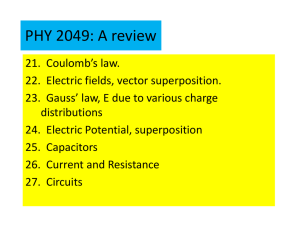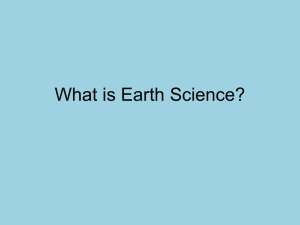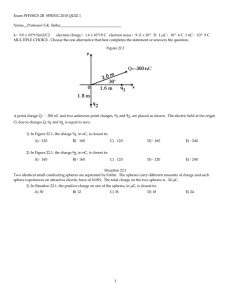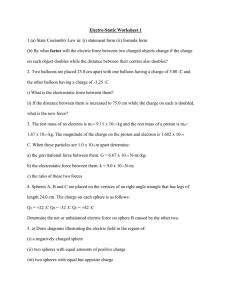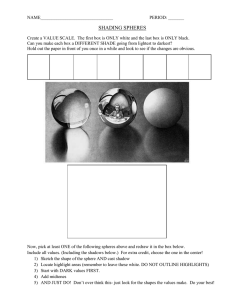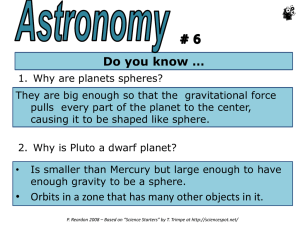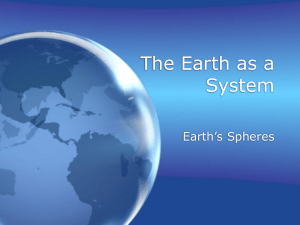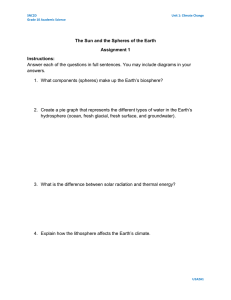Coulomb`s Law
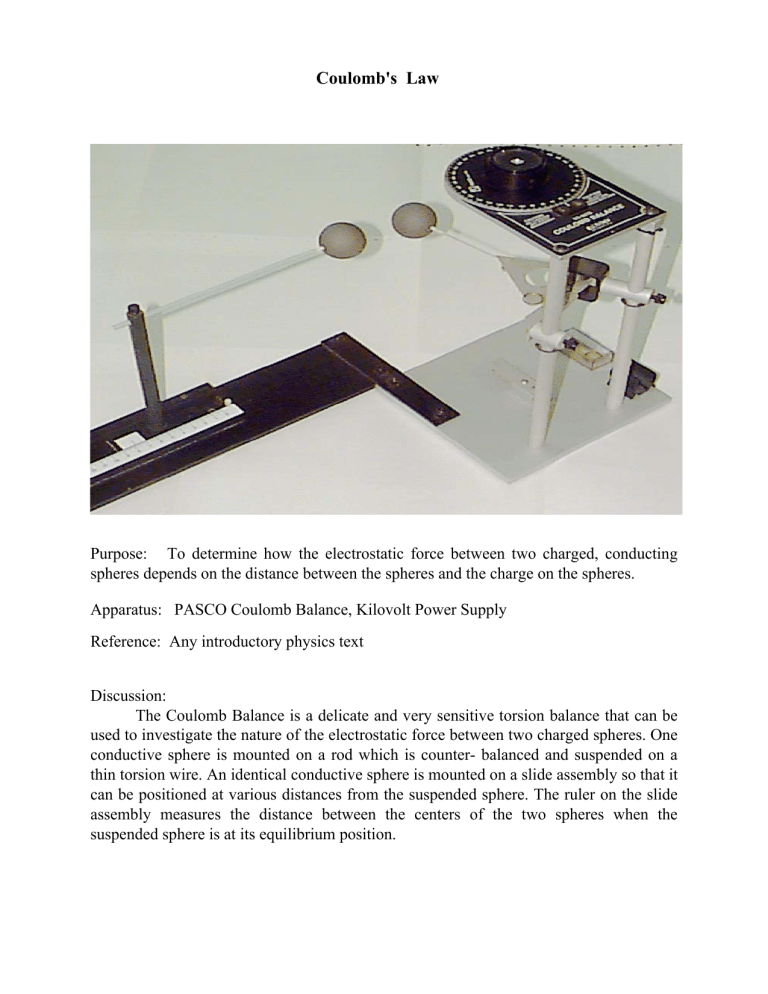
Coulomb's Law
Purpose: To determine how the electrostatic force between two charged, conducting spheres depends on the distance between the spheres and the charge on the spheres.
Apparatus: PASCO Coulomb Balance, Kilovolt Power Supply
Reference: Any introductory physics text
Discussion: used to investigate the nature of the electrostatic force between two charged spheres. One conductive sphere is mounted on a rod which is counter- balanced and suspended on a thin torsion wire. An identical conductive sphere is mounted on a slide assembly so that it can be positioned at various distances from the suspended sphere. The ruler on the slide assembly measures the distance between the centers of the two spheres when the suspended sphere is at its equilibrium position.
The spheres are charged by means of a very stable kilovolt power supply and a charging probe. In this way, a definite, reproducible quantity of charge can be placed on each sphere. The electrostatic force between the spheres causes the torsion wire to twist and the experimenter then twists the torsion wire in the opposite direction so as to bring the balance back to its equilibrium position. The angle through which the torsion wire must be twisted to reestablish equilibrium is measured; this angle is directly proportional to the electrostatic force between the two spheres. By varying the distance between the spheres and the amount of charge on the spheres, it is possible to verify Coulomb's Law:
F = k Q
1
Q
2
/ R
2
Although it is possible, using this apparatus, to measure the value of the constant, k, appearing in Coulomb's Law, we will not attempt to do so in the present experiment.
We will attempt to verify that the value of the exponent of R is 2 and that the force is proportional to the product of the two charges.
Procedure:
CAUTION: THE APPARATUS IS VERY DELICATE AND MUST BE HANDLED
WITH CARE. Please pay close attention to using proper technique. Do not touch the spheres with your hands. If in doubt about any procedure, ask!
A. Force versus Distance.
1. Move the sliding sphere to maximum separation. Make sure that you and the spheres are fully discharged by grounding momentarily (a grounding probe is provided). Always touch the probe to the suspended sphere very gently from below. Set the torsion dial to
0 o
and check that the torsion balance is properly zeroed. If not, ask for assistance from the instructor.
2. Set the voltage control on the kilovolt power supply at maximum. Do not turn it on until you are ready to charge the spheres. Charge both spheres by touching each one momentarily (1 second is more than enough time) with the charging probe. Always touch the suspended sphere very gently from below. Immediately after charging the spheres, turn off the power supply but leave the dial set at maximum.
3. Position the sliding sphere at a distance of 20 cm. Slowly adjust the torsion dial so as to bring the balance back to its equilibrium position. Try not to overshoot the equilibrium position, so as to avoid time consuming oscillations! When equilibrium is achieved, record the value of the angle,
θ
, as read on the dial to the nearest half degree or better.
4. Move the sliding sphere back to maximum separation and repeat step 2, to recharge the spheres. This must be done between measurements to minimize the effects of charge leakage.
5. Repeat step 3. Do not look at the dial while you are rotating it! Try to obtain honest, independent measurements. Repeat this measurement several times until you have obtained three measurements which agree within two degrees. Use the average of those three measurements as your final result (expressed to the nearest tenth of a degree).
6. Repeat steps 1-5 for distances R = 14, 10, 7, 6, and 5 cm. If the zero has shifted, you will have to repeat the previous set of measurements. You may wish to make measurements for other values of R if time permits.
B. Force versus Charge
With the separation between the spheres held constant at R = 5 cm, measure the force for different values of the charge, keeping Q
1
= Q
2
always. The charge transferred to a sphere is proportional to the charging voltage. Thus, we can produce different charges on the spheres by adjusting the voltage of the power supply. Use meter settings of 6, 5, 4, 3,
2, and 1. Always ground both spheres before charging and make sure that they are at maximum separation during charging. Follow the same procedures outlined in part A.
You will obtain six data points by this method.
(Optional): The charge on a conducting sphere can also be changed by a known amount by bringing it into contact with another conducting sphere. If the second sphere is initially uncharged and is identical to the first, then the original charge on the first sphere will be shared equally between the two spheres. An analogous argument can be constructed to determine the charge when three identical spheres are brought into contact.
Use this method to produce charges of (i) Q
1
= Q
2
= Q/2 and (ii) Q
1
= Q
2
= Q/3, where Q is the charge placed on each sphere when the power supply is set at 6. Measure the force corresponding to (i) and (ii) to obtain two more data points.
Analysis of Results:
Because we are using charged spheres rather than point charges to test Coulomb's Law, the effective distance between the charges is not equal to the distances between the centers of the spheres. An approximate expression for the effective distance, adequate for our purposes, is given by:
R' = R (1 + 2.3
β
) with
β
= a
3
/ R
3
and a = 1.90 cm where R is the distance between the centers of the spheres and a is the radius of each sphere. It is assumed here that the conducting spheres are identical and carry identical charges.
A.
For each value of R used in part A, calculate R' using the above expression.
Tabulate your data, listing: R,
θ
, R', 1/(R')
2
, ln R', and ln
θ
.
1. Plot ln
θ
versus ln R'. Draw the best straight line that you can through your data points and determine the slope of this line. Estimate the uncertainty in this slope. Refer to the sample graph given.
What does the slope of this line tell you?
[ Hint: If
θ
= b (R') n
, then ln
θ
= ln b + n ln R' ]
2. Plot
θ
versus 1/(R')
2
. Draw the best straight line that you can through your data points. Should this straight line pass through the origin? What can you conclude from this graph?
B. Let Q = 6 (in arbitrary units) where Q is the charge on each sphere when the charging voltage reads 6 on the meter. Construct a table of
θ
versus the value of Q
1
x
Q
2
for each of the (6) data points obtained and construct a graph of these data. What can you conclude from this graph?
Questions to be answered in your report:
1. Explain, qualitatively, why the effective distance between the spheres, R', is always greater than the distance, R, between their centers. A diagram, showing the distri-bution of charges on each conducting sphere, should be included as part of your explanation.
2. When the spheres are very far apart, the correction to R is very small, i. e., R' = R.
However, as the spheres are brought closer together the correction becomes larger, i. e., (R'- R) / R increases as R decreases. Explain, on physical grounds, why this must be so, referring to your answer to question 1.
3. Identify as many possible sources of errors in these measurements as you can think of and, in each case, suggest ways in which the error might be reduced experimentally or corrected for in some fashion.
